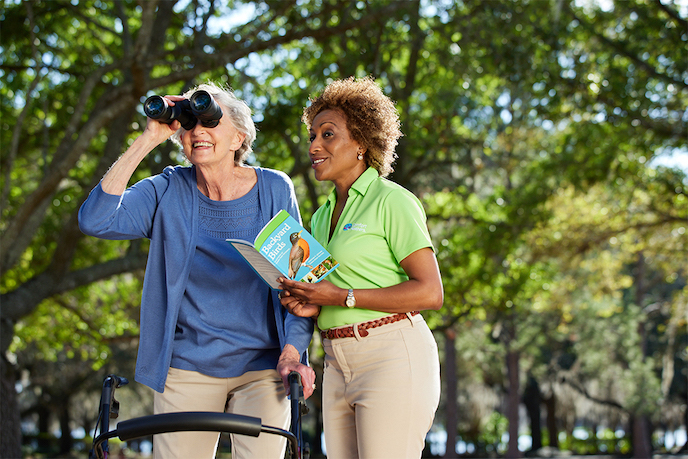Seniors Benefit from Physical Activity when Living with a Health Condition
As we age, older loved ones are more likely to suffer from at least one chronic disease that leads many to exercise very little and fail to take advantage of some of the benefits of physical activity. The good news is that those with a health condition can still benefit from physical activities and exercise.

Regular physical activity is essential, no matter one's age. Being physically active can improve brain health, help manage weight, reduce the risk of disease, and strengthen bones and muscles while improving the quality of everyday activities. The benefits of regular physical activity can lead to a long life filled with moments of joy.
As we age, older loved ones are more likely to suffer from at least one chronic disease that leads many to exercise very little and fail to take advantage of some of the benefits of physical activity. As a matter of fact, at least 86% of seniors live with one chronic condition.
The good news is that those with a health condition can still benefit from physical activities and exercise. The National Institute on Aging recommends the following activities for exercising with chronic conditions that often impact the quality of life in our later years.
Alzheimer's disease and related dementias
Being active and getting exercise may help people with Alzheimer’s or another dementia feel better and can help them maintain a healthy weight and have regular toilet and sleep habits. Some activities to share with a caregiver are a walk each day, dance to music, or simple task around the house. Some things that help one stay active around the house include sweeping, dusting, lifting household items such as soup cans, or pedaling on a stationary bike. Moreover, a study published in Nature Metabolism reports that irisin, secreted by muscles during exercise, could be an effective therapeutic for addressing brain deficits resulting from Alzheimer's disease.
Arthritis
Exercise can reduce joint pain and stiffness for those living with arthritis, helping 50% of people aged 65 years or older that experience arthritis. Flexibility exercises such as upper- and lower-body stretching and tai chi can help keep joints moving, relieve stiffness, and give you more freedom of movement for everyday activities. Strengthening exercises, such as overhead arm raises, help maintain muscle strength to support and protect joints. Endurance exercises such as swimming make the heart and arteries healthier and may lessen swelling in some joints.
Type 2 diabetes
Exercise and physical activity can help manage Type 2 diabetes. Walking and other daily exercises can help improve glucose levels in older people with diabetes. A few simple and easy steps to take each day include stretching during tv commercials, walking around when talking on the phone, and parking further away from our destination when running errands.
Osteoporosis
Osteoporosis becomes more prevalent as people age, with nearly 27% of women 65 and older having osteoporosis. Luckily, fun activities like walking or dancing three to four times a week help to build muscle and strengthen bones, all examples of weight-bearing exercises that work against gravity. Additionally, strengthening and balancing exercises like Tai Chi or practicing balancing on one leg can help avoid falls.
For seniors, the second edition of the Physical Activity Guidelines for Americans recommends at least 150 minutes a week of moderate-intensity activity such as brisk walking, at least two days a week of activities that strengthen muscles, and, essential at this age, exercises to improve balance. Of course, one should aim for the recommended activity level, but be as active as one is able.
Comfort Keepers® Can Help
Caring for others and ourselves can take a lot of thought and preparation as we age. Our Comfort Keepers® can help encourage seniors to meet activity guidelines, recommend ways to add more physical activity to their day, and can help to motivate a senior to stay active. Our trained caregivers can provide transportation to a local park, a trail, or greenways to enjoy the outdoors together. Drive clients to scheduled doctor appointments, provide mobility assistance and meal preparation, and help with activities of daily living.
We believe in Elevating the Human Spirit℠ by providing our clients with practical assistance and daily moments of joy. By giving equal parts compassion, attention, and comfort, our goal is to help seniors feel independent again while promoting good health to enjoy their days.
References:
Cleveland Clinic: Living With a Chronic Disease? 4 Best Tips for Exercising
Centers for Disease Control and Prevention: Adults with Chronic Health Conditions and Disabilities
Centers for Disease Control and Prevention: Physical Activity for Different Groups
U.S. Department of Health and Human Services: Physical Activity Guidelines for Americans
Harvard Medical School: Exercise and Alzheimer’s Disease
National Institute on Aging: Exercising With Chronic Conditions
Centers for Disease Control and Prevention: Physical Activity Prevents Chronic Disease
Sign up to receive helpful info right to your inbox.
We understand choosing an in-home care provider can be a difficult decision, and we want to make your journey as easy as possible. We're here to support you by providing helpful senior care tips and information on in-home care and senior health and wellbeing topics.
Start a Job with a Purpose
Uplifting training and support for you every step of the way.
Apply to be a caregiver







